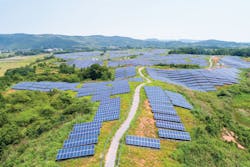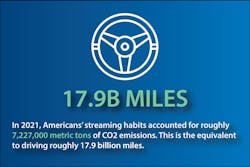Streaming and Sustainability – The Sticking Point
Did you know that Americans streamed nearly 15 million years’ worth of video content in 2021? That’s a lot of Netflix and chill!
But there’s another side to this story that hasn’t been told. Believe it or not, in 2021, Americans’ streaming habits accounted for roughly 7,227,000 metric tons of CO2 emissions—55g of CO2e for every hour of streaming. This is the equivalent of driving roughly 17.9 billion miles, considering the average gas-powered car emits 404 grams of CO2 per mile.
This staggering number highlights a pressing, but often overlooked problem: the explosion of video streaming—along with the exponential increase in volume and quality of video files—is taking a major toll on our planet.
And while there is a growing desire to flawlessly stream immersive experiences, live sports and more, consumer demand for environmentally friendly brands has never been greater, creating an urgent need for CSPs, streamers and video service providers to address the sustainability crisis at hand.
Winning the streaming war is no longer just about content, it’s about sustainability too. Addressing this challenge requires more energy-efficient ways to stream, without sacrificing the viewing experience.
Caching – Every Bit Counts
While streaming should feel effortless for the end-user, delivering just one piece of media often relies on a large amount of energy and infrastructure, including data centers, networks and a growing abundance of end-user appliances and other technologies. All this energy-guzzling hardware adds to streaming’s growing carbon footprint, and newer forms of data-heavy content will only fan the flames if left unchecked.
8K programming, for instance, requires a bit rate of 100 Mbps or 40 times more bandwidth than streaming HD. Imagine the challenge when distributing 8k content live and at global scale, while ensuring a flawless viewing experience to millions of viewers during peak traffic.
When downtime is not an option and demands are high, many organizations turn to additional servers as a solution to handle the increased load. But from a sustainability perspective, this requires more energy and, as a result, increased carbon emissions. Rather than investing in costlier, more power-consuming infrastructure or accelerators, organizations can avoid unnecessary hardware investments by increasing cache performance and by processing data more efficiently—ideally, only once.
New technologies and approaches to content delivery are improving throughput and provide greater control over caching and invalidation strategies.
For example, organizations can benefit greatly by specifying the ideal time-to-live for items in a cache, or efficiently purging and updating cached items rapidly as content changes. Adjusting load balancing and traffic routing can ensure content is always delivered from the optimal location for the best user experience possible.
“This staggering number highlights a pressing, but often overlooked problem: the explosion of video streaming—along with the exponential increase in volume and quality of video files—is taking a major toll on our planet.”
Optimizing Software Can Help
Greater performance per server means less hardware requirements overall. Therefore, maximizing throughput per single server will be essential to effectively deliver next-gen content and drastically reduce data center requirements.
While updating to the latest hardware can help, this is also costly and still not effective if paired with the wrong architecture. And that’s not to mention the material waste from outdated equipment after it’s been discarded.
Software-defined solutions, on the other hand, provide more options than ever to optimize old or new systems for the best performance and I/O possible. This helps organizations not only get the most out of their hardware—and therefore, improve sustainability—but also future proofs systems and infrastructure, reducing overall expenses.
Organizations must optimize their software stacks to meet the needs and challenges of the infrastructure and equipment at hand—whether it be bare metal, virtualized, containerized or cloud environments. Each may require a different approach. Additionally, solutions may need to be packaged and optimized for specific use cases and the associated challenges, including streaming, private CDN deployments, and web and API acceleration.
For example, implementing non-uniform memory access (NUMA) can enable multiple processors to utilize the same memory and I/O resources locally. NUMA can provide many advantages: data flows faster with lower latency, the need for data replication is reduced, and the architecture is highly scalable and responsive.
Deliver at the Edge
As the distance that data travels increases, so does latency and the energy consumed. This makes delivery at the edge important to not only performance and power, but also price.
By caching at the edge, data can be processed and stored closer to end-users, reducing network hops and the distance across networks, as well as adding scalability and robustness to the delivery process. It also requires fewer energy-burning resources, like core data centers, to handle increased traffic without sacrificing speeds.
As 5G accelerates, edge-based content delivery solutions will continue to evolve to meet complex requirements on a plethora of IoT devices. For example, initiatives like the EBU 5G-EMERGE project are combining satellite communications with advanced web caching and content delivery at the edge. Unique approaches like this can provide greater capacity, scalability, reach, and have the potential to be cleaner than current distribution methods; however, measurement would be needed to prove any benefits.
Forging a Greener Future
It can be difficult for CSPs, streamers and media companies to measure their overall carbon emissions, but the need for sustainability isn’t going away—it’s only growing stronger. Addressing this challenge requires that we take a closer look at the systems and infrastructure in place today, so that we can improve technology and establish more sustainable methods of streaming for tomorrow.
"For example, initiatives like the EBU 5G-EMERGE project are combining satellite communications with advanced web caching and content delivery at the edge. Unique approaches like this can provide greater capacity, scalability, reach, and have the potential to be cleaner than current distribution methods; however, measurement would be needed to prove any benefits."
Sustainable steaming isn’t just one company’s problem—it’s all of ours. This is where organizations, such as the Greening of Streaming alliance, can play a pivotal role in helping to bring together global industry players in government, media and technology to address the impact of streaming on the environment.
As demand for flawless streaming experiences continues to grow, there will be even greater need to future-proof infrastructure, the industry, and our planet.
About the Author
Adrian “AJ” Herrera
Chief Marketing Officer, Varnish Software
Adrian “AJ” Herrera is Chief Marketing Officer at Varnish Software. He brings 20+ years of experience helping to establish and grow innovative software, cloud, storage and services to the M&E and enterprise markets. For more information, email [email protected] or visit www.varnish-software.com. Follow AJ on LinkedIn: https://www.linkedin.com/in/adrianjherrera/.
Follow Varnish Software on:
Twitter: https://twitter.com/varnishsoftware
LinkedIn: https://www.linkedin.com/company/varnish-software/
Facebook: https://www.facebook.com/varnishsoftware
Github: https://github.com/varnish/
YouTube: https://www.youtube.com/channel/UCfW50IdBJMZwoYIeTvKdflQ


